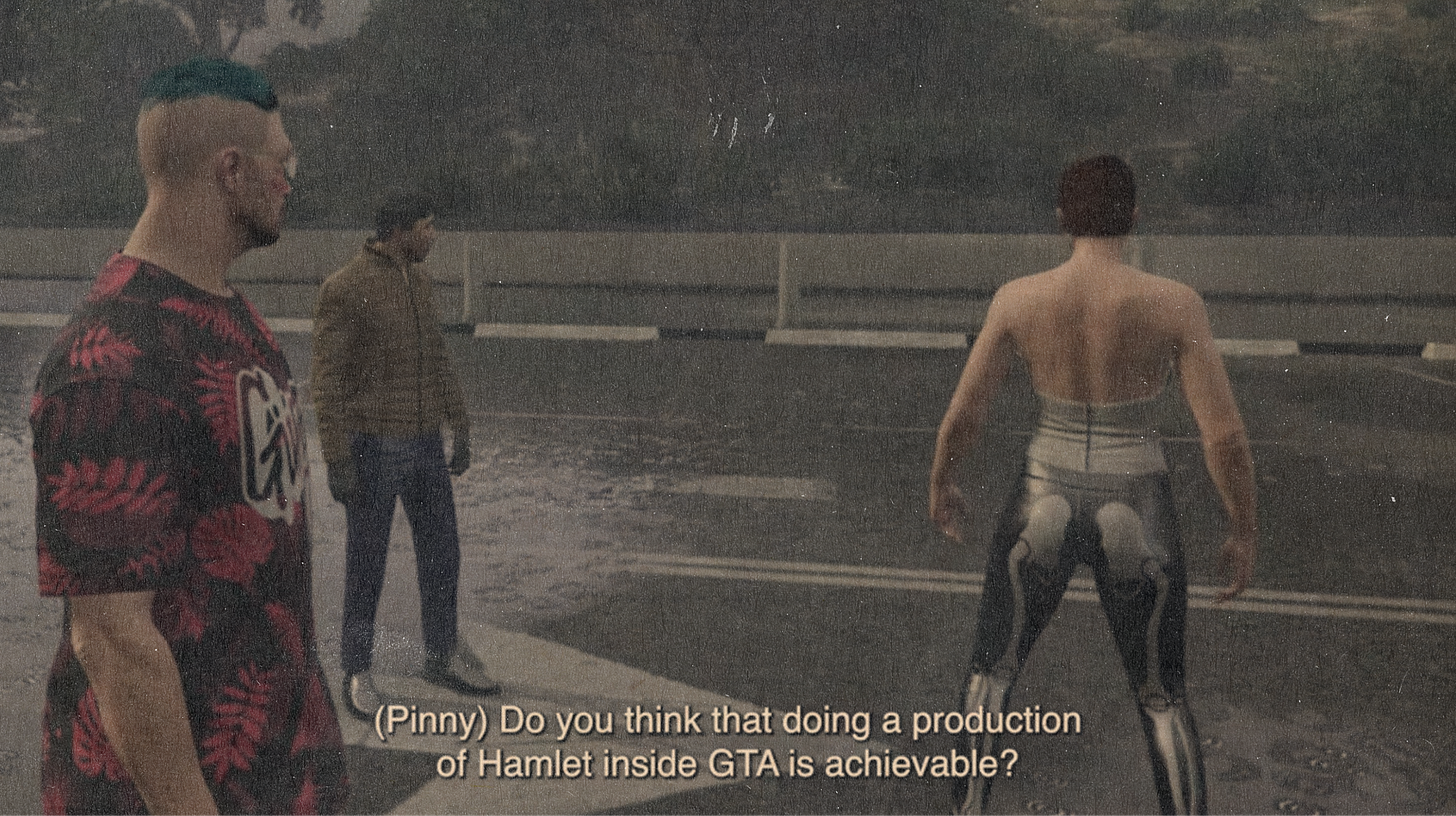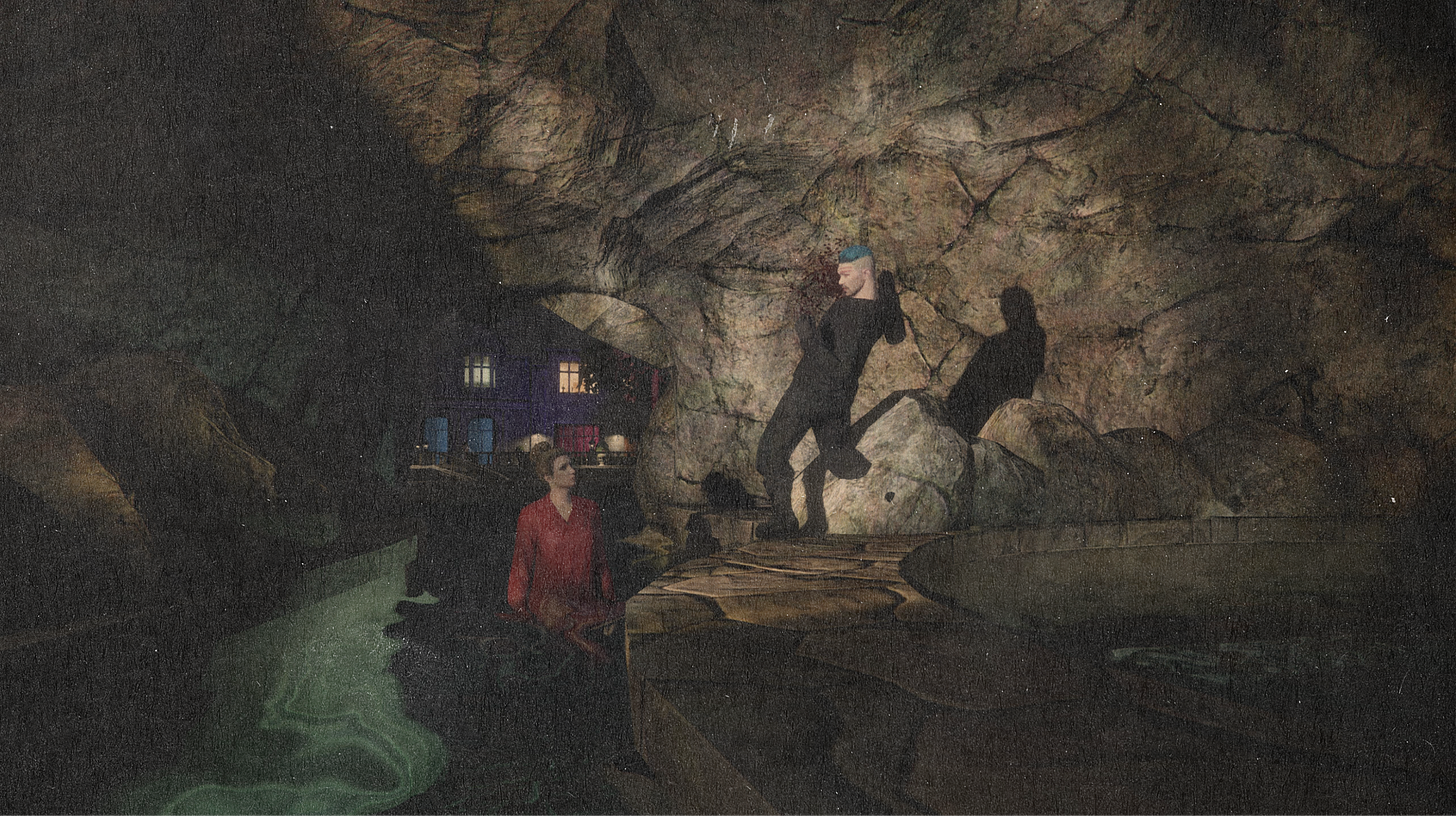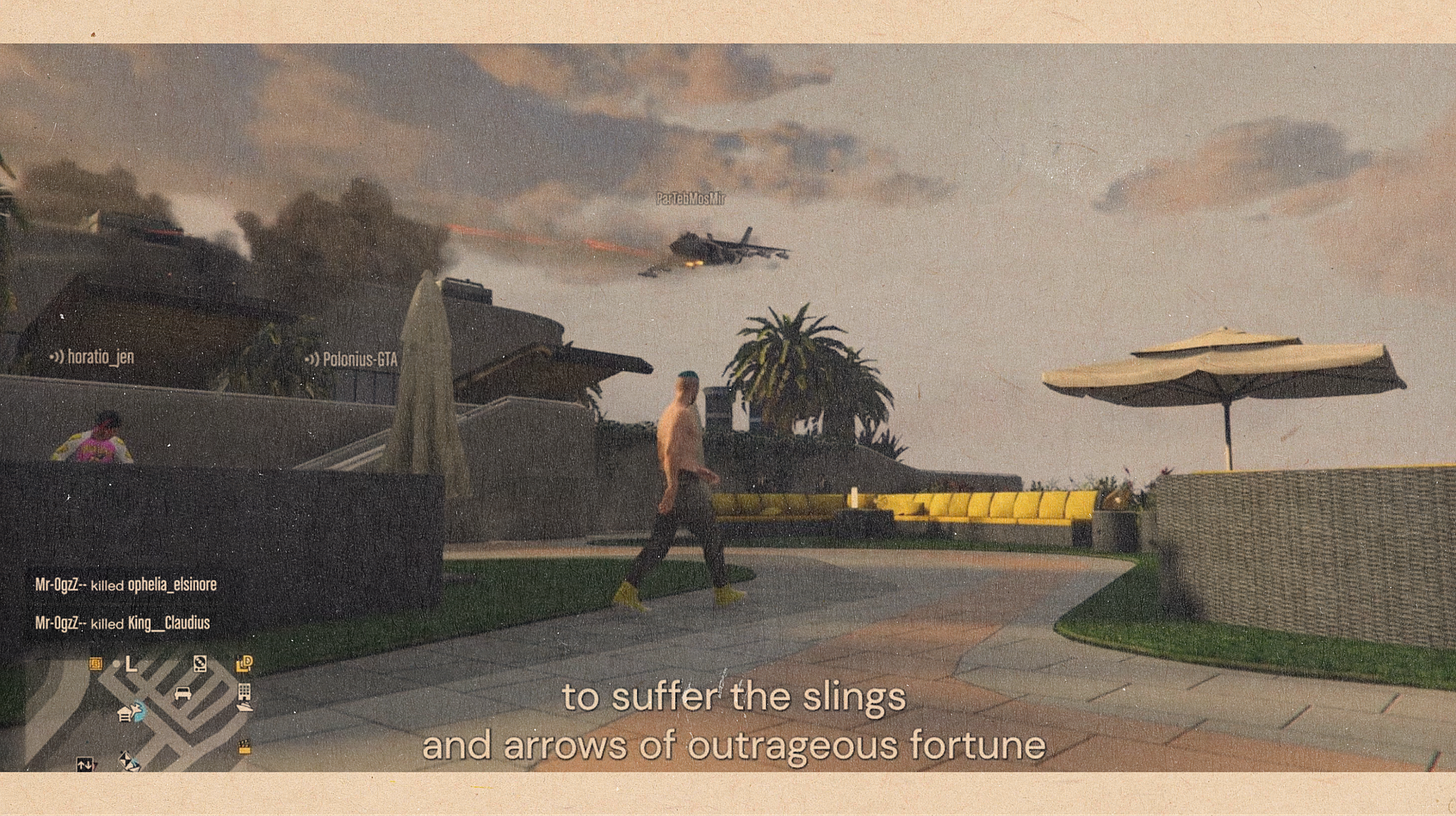Based On, If Any: Grand Theft Hamlet (2024)
The Game’s the Thing
Brittany Menjivar is watching adaptations. Previously, she watched Nosferatu, The Polar Express, Secretary, Rave Macbeth, and The Great Gatsby.
“All the world’s a stage, and all the men and women merely players,” wrote Shakespeare. By players, he of course meant actors—but what if he had been talking about gamers? This is the unlikely question that Grand Theft Hamlet dares to ask. GTH, if you will, follows actor buddies Sam Crane and Mark Oosterveen as they wander around Grand Theft Auto’s virtual paradise-slash-purgatory Los Santos during the height of pandemic, eventually coming up with the idea to bring their passion into the game. They enlist Crane’s wife Pinny Grylls, a documentarian, to help them stage a production of Hamlet with other GTA Online users, recording their efforts all the while. Co-directed by Crane and Grylls, with Oosterveen on board as an associate writer and director, the doc investigates what it means to look at storytelling as a social act, whether said storytellers are wielding physical props or pixellated ones.
I hadn’t planned to return to another Shakespeare adaptation for this column so soon—but when I read an early review of Crane and Grylls’ film, I knew I needed to get into it. First of all, the film seemed like the perfect spiritual successor to Rave Macbeth. While Klaus Knoesel’s 2001 adaptation of the tragedy doesn’t directly reference video games, the gamer ethos is certainly tangible in the film’s stylistic choices, from glitchy special effects to an outro that calls to mind character selection menus. Second, I was lucky enough to catch one of the final performances of immersive Macbeth production Sleep No More in January, which has sparked plenty of rumination on the nature of “interactive” art. At this point, almost every medium has received the interactive treatment: Choose-Your-Own-Adventure stories gave way to apps like Episode and its saucier siblings; Netflix let us play director with Black Mirror: Bandersnatch. Yet nothing hits as hard as immersive theatre, perhaps because theatre itself, live and up close, is already such an intimate medium. If you really wanted to, you could make any theatrical production interactive by rebuking all social strictures and rushing the stage. By transposing Hamlet into GTA Online’s open-world format, in which random players can run around and interact with others as they please, Crane and Grylls had found an authentic way to recreate this precious precarity in the digital realm. I absolutely had to tune in.
Perhaps because of the subject matter, I expected Grand Theft Hamlet to be a bit more like the YouTube docs I’ll catch snippets of when glancing at my boyfriend’s computer: explanatory narration over gaming footage, perhaps with the occasional cutaway to reference images for context. In actuality, the entire film consists of in-game screen recordings, in terms of both visuals and audio. The opening scenes show Crane and Oosterveen roaming around Los Santos, a near-perfect recreation of Los Angeles, chatting about life under quarantine in England. I was shocked by their British accents—partially because GTA registers to me as such a quintessentially American series, and partially because they reminded me that to play a video game is itself a form of playing pretend. Crane, Oosterveen, and Grylls don larger-than-life avatars that don’t necessarily resemble them—as is evidenced when Grylls logs on for the first time and decides she wants to look like Tilda Swinton. They partake in behavior that bears no resemblance to their everyday activities—i.e., Crane pulling out a gun and shooting another character during an interstitial scene just because he’s bored. All things considered, the play is ultimately a simulation within a simulation—an inadvertent metaphor for quarantine, in which daily activities seemed irrelevant and yet the world outside one’s own “bubble” felt even more fake.
Grand Theft Hamlet is also fascinating in that it zeroes in on the set of narrative circumstances that must be met in order to pull off a convincing Shakespeare spin-off. As I discussed in my Rave Macbeth piece, you can’t just click and drag your favorite Shakespearean ensemble into any old setting, since formal hierarchies and murder plots are typically involved. It wouldn’t make sense to do Hamlet in a dentist’s office and have a hygienist take out the doctor with a drill—but the no-holds-barred city of Los Santos serves as the perfect backdrop. At one point, Crane remarks “People are violent in Shakespeare. It’s fucking brutal”; shortly after, various in-game shootouts ensue. Sometimes their audience members even pull weapons on them. Not only does Los Santos make sense on a story level—the tension between the actors’ avatars and gunslinging passersby recalls the tension between the bureaucracy of aristocratic society and the rage that underscores the human experience.
As you might have gathered by this point, Grand Theft Hamlet is less about the artistry involved in the rehearsal process than the logistical and interpersonal challenges involved in getting such a project off the ground. The most intriguing characters—a man who recites the Quran during his audition, a shirtless dude in a top hat who turns out to be a literary agent using her nephew’s account—don’t stick around, hinting that there might be some bugs in our filmmakers’ system (metaphorically speaking). Indeed, technical difficulties follow. The actor originally chosen to play Hamlet has to downgrade to a smaller role after receiving a role in an IRL production as businesses are beginning to open up again. Grylls goes from embarking on virtual dates with Crane, recreating the thrill of their early relationship, to arguing with him because he’s been prioritizing the game over real-world engagements. As much as GTA offers a forum for social connection, it can’t replicate face-to-face interaction. And yet its slippery qualities are exactly what make it special. The Quran man and dapper agent make for some of the documentary’s best moments, alternately amusing and moving. A strange, silent user is dubbed the production’s honorary “stage manager” in an oddly tender interaction. The World Wide Web isn’t always reliable—but it’s reliably whimsical, and whimsy is a crucial aspect of any creative practice.
Grand Theft Hamlet ends with Crane, Oosterveen, and Grylls on a speedboat, taking a cluster of audience members to a yacht named “the H.M.S. Elsinore” for the show. We don’t get to watch the entirety of the performance, but knowing it happened is enough—as is the case with so many great Internet rumors. As the filmmakers make their rounds on the festival circuit, one can’t help but wonder whether their masterpiece will ever screen at the Vinewood Bowl—the animated amphitheater where their dream was born.





